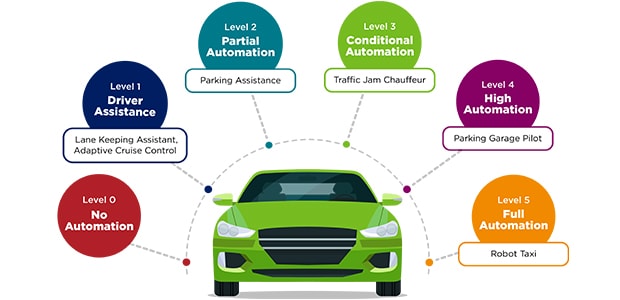
TE Perspectives
Slower – But Safer – Journey Toward Autonomous Vehicles
By Ralf Klädtke, VP & CTO, Transportation Solutions
We are currently experiencing a wave of unprecedented technological innovation, a rapid evolution that will materially impact every facet of how we live—including the way we travel. Our global society’s focus on electrification and sustainability has expedited the rise of electric vehicles much more quickly than anyone had imagined. To the contrary, the forecasted millions of autonomous passenger cars and robotaxis that were predicted to have already been filling our roadways have not yet arrived. What happened?
TE works with virtually every OEM globally to enable autonomous safety technologies that support automated (level 2+) self-driven cars and fully autonomous (level 5) robotaxis, cars and trucks.
- TE works with virtually every OEM globally to enable autonomous safety technologies that support automated (level 2+) self-driven cars and fully autonomous (level 5) robotaxis, cars and trucks.
Mixed traffic – automated and autonomous passenger cars
In hindsight we must admit that autonomous (level 5) passenger cars are facing higher technical and liability challenges than were initially envisioned. When combining self-driven cars with autonomous cars in all weather conditions like heavy rain or snowfall, or in urban areas with bicycles or undefined construction areas, autonomous cars are presently unable to provide the flawless level of safety that is required. In these scenarios, the risks of injuries or fatalities from accidents, as well as the associated liability issues, are slowing down the implementation of fully autonomous driving.
What’s more, autonomous car passengers will likely be frustrated with their experience in mixed traffic, especially if there is a reckless human driver nearby. All of the autonomous cars will prioritize safety and will hit the brakes immediately. But that also means a longer time on the road and a less efficient driving experience. Autonomous vehicles will always be the slowest in mixed traffic conditions.

As we evolve to a fully autonomous state, we are presently experiencing strong growth in Level 2+ passenger car automation. These automated cars have modern driver assisted technologies like forward collision assistance or lane assistance and partial automation that support, but do not replace, the driver. With these automated features, the liability remains with the driver. Due to the benefits and strong consumer interest in these features, automated passenger vehicles are forecasted to grow annually by more than 20% over the next several years.
Autonomous trucks
Even greater growth, however, is predicted for autonomous (level 5) trucks. As “zillions” of packages are ordered online around the world and must be delivered daily, the shortage of truck drivers is becoming a major bottleneck. In addition, this growth is being driven by favorable economics, as there is a prediction of an up to 45% savings in the total cost of ownership for autonomous (level 5) trucks.
In well-defined areas like highways and climate zones without heavy rain or snow, we will increasingly see the “platooning” of trucks, where two or three or even more trucks will operate like a road-train with only one driver in the first truck. By the late 2020s, it is expected that autonomous trucks will be present on virtually all highways individually or in platoons.

Controlled areas / megacities – autonomous robotaxis and passenger cars
As mixed traffic is causing significant challenges for rapid implementation of fully autonomous vehicles, we will, however, see autonomous driving implemented much earlier in controlled or geo-fenced areas. At airports or in specific lanes reserved for autonomous vehicles, the implementation of fully autonomous (level 5) robotaxis or passenger cars is already feasible today. Operating in controlled areas limits the complexity of operational scenarios to be handled and accelerates the implementation of driverless autonomous driving.
In megacities of 10+ million people it is likely that the inner circle of the megacities will become a controlled area and self-driven cars will be banned from that area. In such a controlled area, the operation of autonomous robotaxis and passenger cars will be efficient and safe.
Autonomous safety – zero fatalities
Today, we are still facing an epidemic of 1.3 million people killed each year in traffic accidents globally. Those fatalities are not acceptable. Autonomous technologies from level 2 to level 5 of autonomy, reducing human errors on roads, will enable a quantum leap toward the objective of “zero fatalities.” Up to 50 sensors (visual camera, radar, lidar) will provide huge amounts of data, along the lines of 25+ gigabits per second. Artificial Intelligence (AI) and sensor fusion are demanding ever increasing huge amounts of data to be processed in real time to operate safely in the myriad situations on the road. For example, just one autonomous car will use 40 times more data in just one hour (4,000 GB) than all 270 million Twitter users produce in an entire day (100 GB). Transmitting such massive amounts of data in real-time is critical and the data connectivity solutions that TE develops and produces in many countries around the globe enable manufacturers of automated, autonomous or platooning vehicles to analyze and process in real time any traffic scenario and to avoid accidents and fatalities on the road to eliminating fatalities.

Sustainability and Safety are winning
In the race for autonomy and zero fatalities, it is not important whether passenger cars, platooning trucks or robotaxis are winning. What really counts is that we as an industry take a holistic approach to sustainability and safety on the road to zero fatalities. Automated, autonomous and sustainable technologies are being enabled by TE’s more than 8,000 TE engineers globally and we are proud of our work helping to bring the sustainable, autonomous and safe future of transportation to life.
About the Author

Ralf Klädtke
Ralf Klädtke is vice president and chief technology officer (CTO) for TE Connectivity’s Transportation Solutions segment. He is responsible for providing thought leadership and guidance around the future innovation, growth plans and portfolio investments for the Transportation Solutions segment, as well as in guiding the segment’s technology roadmap. Appointed to the role in April 2021, Ralf has over 25 years of engineering and leadership experience with global technology companies. He is a former captain in the German Air Force and also held roles with the German Space Agency (DARA/DLR) and MAN Technologie where he worked on the X-38 crew transport vehicle.
 e
e
 e
e
 e
e



